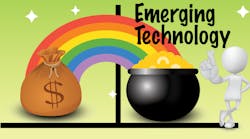Download this article as a .PDF
R&D spending is a hot topic right now. Not since the 1990s has such a steady and possibly increasing amount of funding been on the horizon for inventive scientists and engineers. It is a great time to be in the profession. It is a global trend.
Seven or more years of consecutive increases in R&D spending appear to be lining up in the United States, after a five-year decline from 2010-2014. (MD March 18). Our knowledge of what this consistency means is better than it was in the 1990s. Few could spot a technology boom was coming much before it actually arrived. Today, we better understand that consistent spending does make a difference. And, that the effects of uniformity apply to all companies—unless there is a deep core competency in an area of volatile spending (INSEAD). With better management science, industry will hopefully be able to nurture and sustain this portending boom period.
When times are good and money is easier to come by, a look at the Gartner Hype Cycle for Emerging Technologies. This annual “educated guesstimate” tracks the emergence of new technologies using five life-cycle phases: innovation trigger, peak of inflated expectations, trough of disillusionment, slope of enlightenment, and plateau of productivity. These emergent capabilities are likely to move faster into workplaces and product lines in good times, which is not always a good thing. Not all technology kittens were meant to become cats, but friendly budgets tend to feed more kitties.
Enlightenment: Virtual reality has now broken through to the slope of enlightenment phase. Needs are being identified that have a commercial return. In turn, R&D spending on applications and equipment is increasing. The same cannot yet said for augmented reality.
Disillusionment: Augmented reality is in the trough of disillusionment, and the Pokémon cannot pull it out yet. “Software-defined security” and the big data and analytics initiative of an “enterprise taxonomy” for each company are also in the trough. These are great examples to make the point that the technologies being tracked are highly nascent—i.e., things that may or may not be around a decade from now. There are 28 more hyped technologies in the earlier stages than the four discussed so far.
Inflated Expectations: Smart robots, virtual assistants, connected homes, deep learning, and machine learning are at their peak of inflated expectations. It may seem to many, myself included, that these trains are on the tracks. But that is not the history of Gartner’s Hype Cycle. For instance, Amazon’s Alexa and Google’s Assistant have already disrupted the original connected home vision of a central control system. Equally exciting are autonomous vehicles, cognitive computing, and blockchain that have passed their peak of disillusionment and are sliding into the trough of disillusionment. That seems about right. Just last fall new agreements for autonomous vehicles and driverless trucks were being deployed in numerous settings. They are now being pulled back and slowed down, an indicator of the trough of disillusionment.
R&D Spending Triggered: Edge computing, quantum computing, 5G, human augmentation, and 4D printing have just hit their innovation triggers, the first phase. Lastly, the newest technology to trigger into the Hype Cycle is “smart dust.” According to Wikipedia, it is a system of many MEMS devices with a wide range of RF sensing and identification capabilities. Invented in 1992, it made a cameo appearance in the Hype Cycle in 2003 and did not return until 2013, and remains the most speculative entrant.
Which of these technologies is likely to be part of a possible technology boom in the early 2020s? All things being equal, focus on technologies that are at or past their peak of disillusionment. Seven or more years of consistent spending and some, maybe all of them, will appear in your workplace and product pipeline.

